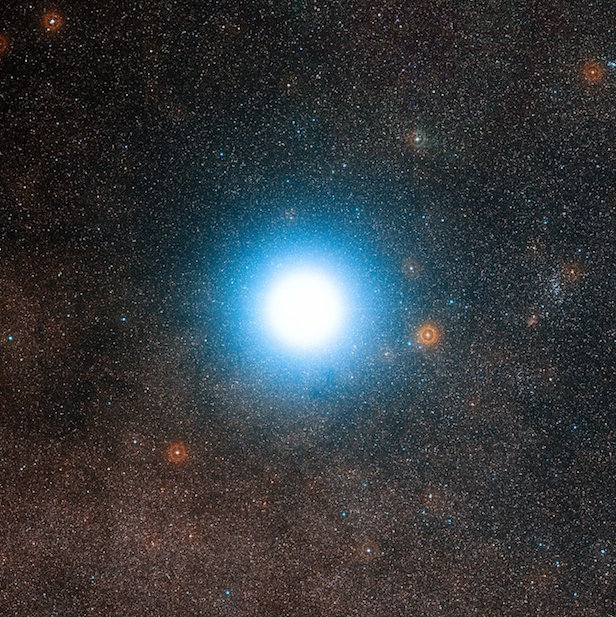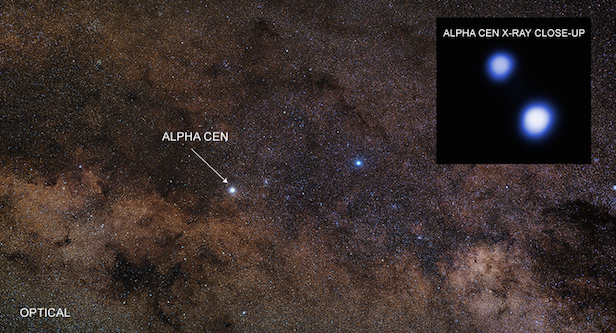Life looks ‘more likely’ around Alpha Centauri
Observations of X-ray emissions around the four-light-year-distant star system shows encouraging signs for habitability of any orbiting exoplanets

Alpha Centauri is the closest star system to Earth, being only four light-years away. Image credit: ESO/Digitized Sky Survey 2
New research by NASA’s Chandra X-ray Observatory has shown promising signs for planetary habitability in the nearest star system to our own, Alpha Centauri. After observing binary system for more then a decade, researchers have encouraging news about a key aspect for habitability, pertaining to the X-ray radiation thrown out by its stellar members. X-rays and intense space weather are harmful to life as it strips away a planet’s atmosphere, but Chandra has revealed that radiation is likely to be low on any worlds in the system.
Alpha Centauri is a triple star system that is only four light years away (25 trillion miles) away from Earth. This is an incredibly short distance in terms of the scale of the universe. “Because it is relatively close, it’s seen by many as the best candidate to explore for signs of life,” says Tom Ayres of the University of Colorado Boulder. “The question is, will we find planets in an environment conducive to life as we know it?”
Alpha Centauri includes a stellar pair separately referred to as ‘A’ and ‘B’, although more commonly known as the collective ‘AB’ as they orbit close to each other. Alpha A is almost a twin of our Sun, as they both have similar ages, masses and sizes. Alpha B is smaller and dimmer than the Sun, but still relatively similar. The third member, Alpha Centauri C (also known as Proxima), is an incredibly smaller red dwarf star that travels around the AB pair in an orbit that is 10 thousand times greater than the Sun-Earth distance. Due to this large orbit, Proxima holds the accolade of nearest star to Earth.
The Chandra data has revealed that the prospect for life around Alpha Centauri A is positive, as X-ray bombardment is less there than the Sun. As for Alpha Centauri B, it only gets slightly worse bombardment. Whereas at Proxima, due to the type of star it is, it is known to frequently emit dangerous flares of X-ray radiation into its circumstellar environment, making life less likely.

X-ray observations reveal a lot about the potentially hazardous intensity of the star’s local environment. Image credit: X-ray: NASA/CXC/University of Colorado/T.Ayres; Optical: Zdeněk Bardon/ESO
“This is very good news for Alpha Centauri AB in terms of the ability of possible life on any of their planets to survive radiation bouts from the stars,” says Ayres. “Chandra shows us that life should have a fighting chance on planets around either of these stars.”
In 2016, an ‘Earth-like’ world was found to be orbiting in the habitable zone of Proxima, however, astronomers have yet to find any sort of exoplanet orbiting the AB pair. The long-term campaign to determine the system’s planetary habitability has had Chandra observing the system’s two main stars every six months since 2005. Chandra is perfect for the job, as it is the only X-ray observatory capable of resolving AB during its current close orbit approach, so that their separate situations can be deduced.
These long-term measurements have revealed the varied X-ray activity of AB, comparable to the Sun’s 11-year sunspot cycle. They have shown that any planet in the habitable zone of Alpha A would receive lower doses of X-ray emission, on average, when compared to the Sun’s habitable zone. As for Alpha B, the X-ray dose for its habitable zone is higher than our Sun, but only by a factor of 5. Planets within the habitable zone of Proxima would receive an average dose of X-rays about 500 times stronger than then Earth and 50,000 times larger during a big flare.
Besides illuminating the possible habitability of Alpha Centauri’s planets, Chandra’s X-ray history of AB plays into theoretical explorations of our own Sun’s cyclical X-ray activity. Understanding this is a key to cosmic hazards such as space weather, which can impact the technology-laden civilization right here on our home world.
Keep up to date with the latest reviews in All About Space – available every month for just £4.99. Alternatively you can subscribe here for a fraction of the price!




